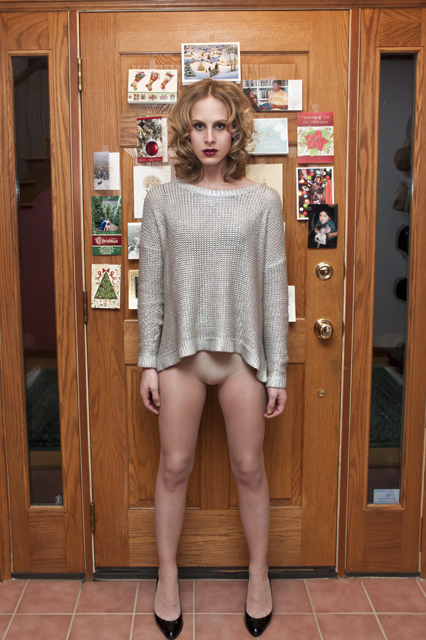Amos Mac is a talented photographer and a bit of a trailblazer. Along with his friend and co-creator Rocco Kayiatos, they publish Original Plumbing (OP), a groundbreaking quarterly publication that documents diversity within the trans male lifestyle. Mac and Kayiatos, also trans men, have created an incredibly important publication in OP; one that offers an intimate peek inside the lives and experiences of its models through honest, striking photographs, essays, personal narratives, and interviews.
Zackary Drucker is a Los Angeles-based performance artist and filmmaker. Her slight frame gives the impression that she is fragile, but she is anything but. Her work is confrontational and unapologetic. Drucker’s notorious piece “The Inability to be Looked at and the Horror of Nothing to See” featured a prerecorded tape of Drucker’s voice instructing audience members to pluck out her body hairs with tweezers as she lay on a table with a steel ball in her mouth wearing only underwear and a blond wig. For those audience members experiencing trepidation, the pre-recorded tape urged them on: “Don’t be afraid, the bitch can take it.”
Drucker is also a trans artist and when the two met at an OP fundraiser in 2009, it left a lasting impression on Mac. About a year later when he decided to venture off on his own with a new project, Drucker was the first person he wanted in his new photographic periodical that would showcase a single trans woman. What resulted was Translady Fanzine, which features intimate photographs of Drucker taken in her childhood home over the course of four days in December of 2010. The periodical also showcases beautifully written, deeply touching letters between Mac and Drucker about their shared experiences as trans individuals and their differences as man and woman.
Translady Fanzine is set to be released this fall. Drucker’s currently working on a new film project and Mac just finished directing a chapter of Valencia, a film adaptation of Michelle Tea’s book, but both took the time to talk to me about their collaboration:
Zackary Drucker is a Los Angeles-based performance artist and filmmaker. Her slight frame gives the impression that she is fragile, but she is anything but. Her work is confrontational and unapologetic. Drucker’s notorious piece “The Inability to be Looked at and the Horror of Nothing to See” featured a prerecorded tape of Drucker’s voice instructing audience members to pluck out her body hairs with tweezers as she lay on a table with a steel ball in her mouth wearing only underwear and a blond wig. For those audience members experiencing trepidation, the pre-recorded tape urged them on: “Don’t be afraid, the bitch can take it.”
Drucker is also a trans artist and when the two met at an OP fundraiser in 2009, it left a lasting impression on Mac. About a year later when he decided to venture off on his own with a new project, Drucker was the first person he wanted in his new photographic periodical that would showcase a single trans woman. What resulted was Translady Fanzine, which features intimate photographs of Drucker taken in her childhood home over the course of four days in December of 2010. The periodical also showcases beautifully written, deeply touching letters between Mac and Drucker about their shared experiences as trans individuals and their differences as man and woman.
Translady Fanzine is set to be released this fall. Drucker’s currently working on a new film project and Mac just finished directing a chapter of Valencia, a film adaptation of Michelle Tea’s book, but both took the time to talk to me about their collaboration:





Comments